
- Poems Poetry Art
- Author
- Alfred French (11)
- Charles Bukowski (12)
- Edgar Allan Poe (16)
- Edmund Spenser (7)
- Eyvind Earle (15)
- Jack Hirschman (16)
- John Hejduk (9)
- John Milton (7)
- Lance Woolaver (7)
- Lindley Murray (8)
- Patti Smith (16)
- Reilly Rhodes (11)
- Shel Silverstein (9)
- Thornton Wilder (6)
- Unknown (9)
- Various (40)
- William Blake (9)
- William Shakespeare (7)
- Wulf Segebrecht (17)
- Yoko Ono (6)
- ... (3205)
- Format
- Board Book (2)
- Books (3)
- Box Set (2)
- Broadside (2)
- Chapbook / Pamphlet (9)
- Cover Rigid (3)
- Hard Cover (2)
- Hardback (10)
- Hardcover (499)
- Leather (6)
- Library Binding (2)
- Mixed Lot (6)
- Paperback (100)
- Paperback / Softback (4)
- Perfect (8)
- Physical (6)
- Record (2)
- Softcover (13)
- Trade Paperback (122)
- Unknown (8)
- ... (2634)
- Isbn
- 0791409910 (4)
- Doesnotapply (10)
- 2911127552 (4)
- 9780300206074 (4)
- 9780500510148 (4)
- 9780520222434 (4)
- 9780692125199 (3)
- 9780742511279 (6)
- 9780801437588 (3)
- 9780820330877 (4)
- 9780962264603 (4)
- 9780982340325 (3)
- 9780982410059 (4)
- 9780996067614 (10)
- 9781419721977 (10)
- 9781433140785 (3)
- 9781457607301 (4)
- 9781852424329 (4)
- 9781933947273 (4)
- 9782364370319 (10)
- ... (3341)
- Item Length
- Language
- Arabic (3)
- Czech & English (11)
- Dutch (5)
- Eng, Gec (3)
- English (1337)
- English, Japanese (3)
- English, Persian (3)
- English, Russian (9)
- French (43)
- Germ, German (4)
- German (45)
- German, Germ (12)
- Hebrew (3)
- Italian (11)
- Japanese (18)
- Latin (11)
- Persian (7)
- Portuguese (3)
- Russian (19)
- Spanish (13)
- ... (1880)
- Type
Tsukioka Yoshitoshi woodblock Poet Narihira and Autumn Wind
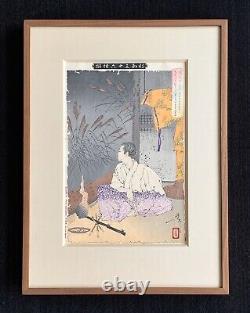
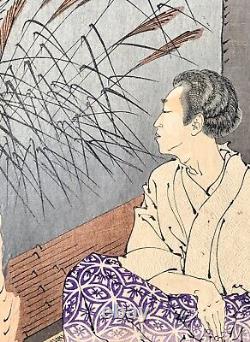


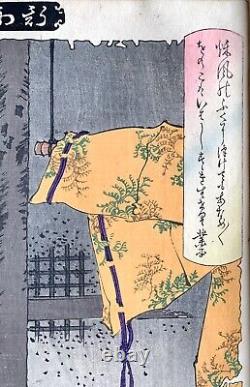
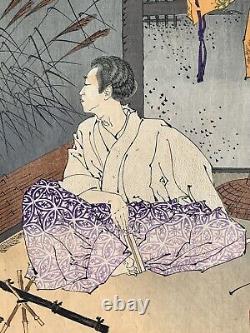
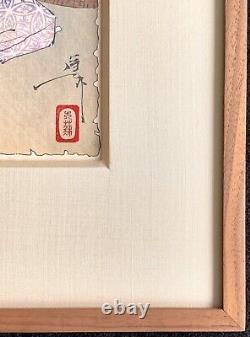
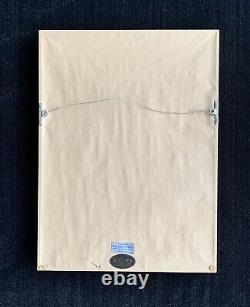


Poet Narihira and Autumn Wind. Visible image measures approximately: 9 1/8" W x 13 3/4" H. Measures approximately: 15 3/8" W x 20 5/8" H. This print is from Yoshitoshi's last woodblock series, New Forms of Thirty-Six Ghosts.
It draws on an array of supernatural tales from both China and Japan. An eighth century prince of the Heian court and. A famous Japanese poet, is seen sitting on the floor by a window overlooking the garden. Narihira was forced into exile for an affair with the empress-designate. He took lodging near the place where a famous poetess and a rare beauty of her time Ono no Komachi died. Alone and moody, he started imagining seeing Japanese pampas grass growing through the eye-sockets of a skull in the garden. He thought it might be the skull of Ono-no Komachi crying. To ponder on the swift passage of human life and to write the poem reproduced in the cartouche.There is nothing more to say. Grass grows through the eye-sockets of Ono's skull.
Narihira's robe is beautifully embossed, with skillful gradation of color on his trousers. The rich robe hanging on the right-hand side and the hat on the floor are a woman's, presumably Ono no Komachi. The son of a Tokyo physician, Yoshitoshi Tsukioka (né Kinzaburo Yoshioka) is considered one of the last great masters of ukiyo-e art. As a young boy he showed remarkable talent and began to study under the renowned Kuniyoshi at the age of 12. Yoshitoshi also studied under Yosai and was adopted by the Tsukioka family.
As modernization pushed ahead, Yoshitoshi suffered a nervous breakdown in 1872, living in poverty and ceasing all artistic production. A year later, he resumed working; adopting the artist name Taiso and fulfilling his creative potential. In 1885, he began one of his most acclaimed series, 100 Views of the Moon. In the spring of 1892, he suffered his final mental breakdown and was committed to the Sugamo Asylum. On the 9th of June 1892, he died of a cerebral hemorrhage at the age of 53.
Yoshitoshi's prints are known for their eerie and imaginative component. He worked in a Japan undergoing rapid change, straddling the domains of the old, feudal systems and the new, modern world.His considerable imagination and originality imbued his prints with a sensitivity and honesty rarely seen in ukiyo-e of this time period. From ghost stories to folktales, graphic violence to the gentle glow of the moon, Yoshitoshi not only offers compositional and technical brilliance, but also unfettered passion.

